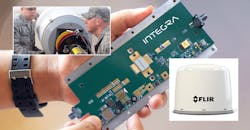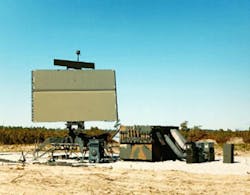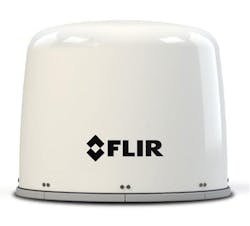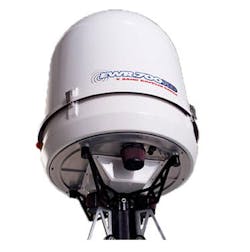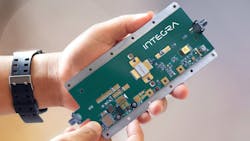Radar Now Travels with the Troops
Download this article in PDF format.
Radar has been a defensive electronic weapon for some time, usually served by large, heavy systems, although the technology is being fit into smaller and lighter packages. Radar transmitters once relied on large vacuum tubes along with their associated full-sized power supplies to power their pulses. The large sizes and weights of these components limited the portability of radar systems in the battlefield.
However, the tide is steadily changing with increased use of solid-state semiconductor technologies such as gallium-nitride (GaN) transistors on silicon (Si) and silicon-carbide (SiC) substrates (see "GaN HEMT Technology Powers Wideband Radars" at the end of this article). As solid-state device technologies gain in power and frequency, high radar output power can be reached with much smaller devices and system packages, making true portability possible. The same radar system that provides a warning from a distance can sit alongside the troops.
One of the larger and “more visible” of these portable radar systems is the AN/TPS-78, a transistorized S-band air-surveillance radar system from Northrop Grumman. The Air Force uses the Doppler radar system for long-range detection, even with the system’s capabilities of rapid assembly and disassembly. It can detect high- and low-altitude targets even when they are surrounded by heavy ground clutter and sea clutter.
By operating at S-band frequencies, the system can work with smaller antennas and electronics than at lower frequencies (longer wavelengths). Along with the antenna, transmit electronics, and receive electronics, the full system can be housed in a compact ISO shelter that’s then transported in a single C-130 aircraft or helicopter and deployed in less than 30 min. It can also be deployed by means of a single all-wheel-drive vehicle (Fig. 1).
1. The AN/TPS-78 is a transistorized, transportable S-band air-surveillance radar system that uses Doppler processing for long-range detection. (Courtesy of Northrop-Grumman)
The same contractor supplies the Highly Adaptable Multi-Mission Radar (HAMMR), which is a derivative of the Ground Based Fighter Radar (GBFR) developed for use by troops on the move. The HAMMR system is a lightweight ground configuration of the lightweight active electronically scanned array (AESA) antenna technology used in airborne fighter aircraft (and in a growing number of autonomous, self-driving commercial vehicles). An AESA antenna provides a full 360-deg. coverage on either an airborne or ground-based vehicle with rapid transport capability.
The HAMMR system is optimized to detect both fixed- and rotary-wing aircraft, cruise missiles, and unmanned aerial vehicles (UAVs) in a relatively small footprint that can serve civil as well as military applications. The modular system, which is adaptable to many different vehicle types for ease of transport, can deliver real-time situational awareness at large public gatherings in addition to providing a protective RF shield around troops in the field.
Early Portability
One of the first man-portable ground surveillance radar systems, the Vietnam War era AN/PPS-5 (dating from 1966), is still one of the most widely used ground surveillance radar systems in the world. Commonly known as a man-portable surveillance and target acquisition radar (MSTAR) system, the lightweight Doppler radar is designed to acquire targets at night and in bad weather. It operates at I- and J-band frequencies and can detect individuals to 5,468 yds (5 km) and groups of soldiers or small vehicles to 10,936 yds (10 km).
The radar system transmits at a pulse repetition frequency (PRF) of 4 kHz and receives reflected returns across 50 channels. It features moving-target-indication (MTI) processing to highlight activity in the field, and the MTI functionality can be turned off to focus on fixed targets.
Designed to be an “assemble it in the field” radar, the system can be made to appear and disappear as needed. It can be bundled into two or three packages, each of which would be carried by a soldier. The radar operates from 8.0 to 8.9 GHz in I-band and 16.0 to 16.5 GHz in J-band, with magnetron-based amplification in earlier systems. Upgrades of MSTAR systems are shrinking with time, with solid-state devices replacing vacuum tubes and their power supplies for transmit amplification.
With its considerable history, AN/PPC-5 MSTAR systems have been viewed by military-system specifiers as “legacy” equipment, with improvements made through upgrades. One of those upgrades was in the form of the AN/PPS-5B man-portable radar system, which boosted the personnel detection range to more than 12 miles for Army in-field users. Another, the AN-PPC-5C, was a low-power variant of the radar system with detection range extended to nearly 15 miles. The British army is and has been a regular user of AN/PPS-5 MSTAR radar systems, continuing to upgrade older systems rather than replace them with new systems.
2. The AN/TPS-75 is a transportable radar system with long-range capabilities used by the Air Force.
The Air Force has had its own favorite transportable radar system, the AN/TPS-75 radar system (Fig. 2). It can cover a 240-nautical-mile area and providing real-time long-range data while communicating via radio, satellite, or microwave link. Data from this mobile ground radar system can be combined with data from other radar systems for a fully integrated battlefield picture. The system is transportable via plane, helicopter, or truck.
Growing Smaller
Newer radar systems designs are taking advantage of the power and efficiency of solid-state transmitters to achieve portability without sacrificing performance. By leveraging device technologies such as SiC and GaN, transistor amplifiers can provide the peak output powers for long-distance target detection with high resolution while running on battery power.
As an example, the B202 Mk 2 radar from Blighter Surveillance Systems Ltd. is a compact radar unit weighing only about 35 lbs. and measuring a mere (approx..) 18.7 × 17.4 × 6.2 in. (474 × 442 × 157 mm). Designed to operate about 12 hours on 12-V vehicle batteries, the medium-range ground surveillance radar uses electronic scanning (e-scan) methods to detect moving vehicles and personnel via simultaneous Doppler and frequency-modulated continuous-wave (FMCW) scans.
A wide vertical elevation beam and passive electronically scanned array (PESA) technology enables the B202 Mk 2 system to detect targets that are close to the radar as well as at some distance. In fact, using only 1-W transmit power at Ku-band frequencies, the ground surveillance radar system can detect moving targets at distances to 8 km. The wide beam enables the system to scan uneven terrain without tilting the radar or its antennas.
Smaller often means less range, or more systems needed for a certain area of coverage, and such is the case with the FLIR Ranger R1 ground-based perimeter surveillance and tracking radar system from FLIR Systems (Fig. 3). It’s small but can accurately detect personnel and vehicles as far as 700 m away. It scans 360 deg. every second, covering areas as large as 1.5 km2 (0.6 miles2). When more coverage is needed, more units are added, such as a mid-range FLIR Ranger R2 radar, and networked to create an overlapping security array.
3. The FLIR Ranger R1 is a ground-based perimeter surveillance and tracking radar system. (Courtesy of FLIR Systems)
Checking Weather
Radar technology is benefitting both military and commercial users when it comes to keeping track of the weather. Companies such as EWR Weather Systems invest in the latest technologies in support of smaller, more portable radar systems, as well as take part as an industry partner of the collaborative adaptive sensing of the atmosphere (CASA).
4. The E7000XD Doppler weather radar embraces solid-state technology and advanced mechanical design for small size and portability. (Courtesy of EWR Weather Systems)
The firm has succeeded in developing small, lightweight radar systems such as the E7000XD Doppler weather radar (Fig. 4). The E7000XD is extremely portable and compact due to mechanical and solid-state design (Fig. 5). Rather than vacuum-tube transmitters, it uses solid-state transmitters with pulse compression techniques to send out longer pulses at lower power levels to illuminate a target.
5. Portable and transportable, the E7000XD Doppler weather radar can be managed by small crews. (Courtesy of EWR Weather Systems)
The company also supplies a portable, non-Doppler weather radar, the E600 Tactical Weather Radar. It provides the capability to determine the location of precipitation cells, the intensity of the coming precipitation, the direction of the weather cell movements, and the speed of the weather cells. Originally developed for use in harsh military environments, the system has become widely embraced by agricultural and industrial users as well.
The latest addition to the company’s 700 series of portable weather radars is the model E750. Its rugged design is well-suited for mobile, temporary, or tactical applications, using dual polarization and a narrow beam width for high resolution in challenging terrain. It can also be used as part of an in-field network of radar systems in which multiple pulses are used to fill gaps in the detection. It employs a solid-state transmitter for portability without lack of resolution, operating at X-band frequencies. The E750 includes a complete suite of meteorological products, including all Vaisala/Sigmet IRIS and EWR/Nexrad Level III products.
AESA antennas are steering many radar designs into smaller packages. In addition to the adoption of solid-state electronics, AESA technology is instrumental in the miniaturization of modern radar systems. Not only does electronic beamsteering shrink the size of the radar antennas, it also eliminates moving parts in older antennas and increases reliability.
Widespread adoption of AESA technology in military radar systems is an ambitious goal of the Spectrum Efficient National Surveillance Radar (SENSR) cross-agency program. Here, industry partners are working closely with the military to consolidate and modernize this country’s aging (and oversized) radar systems.
One of those industry partners is Raytheon, which is working to replace over 600 legacy ground-based radar systems with more versatile, multiple-mission radars capable of supporting air traffic control, air defense and surveillance, border protection, and weather forecasting. Such upgrades are being performed with the simultaneous goals of freeing frequency bandwidth for other applications, such as high-speed communications. Adoption of newer technologies such as AESA not only shrinks the size of the radar systems, but also improves performance. In the case of weather forecasting, severe storms can be identified in seconds rather than minutes, benefiting both civilian and military users.
GaN HEMT Technology Powers Wideband Radars
Solid-state technologies such as gallium-nitride (GaN) semiconductors are making possible smaller, more powerful radar systems at wideband microwave frequency ranges. One firm developing solid-state devices, Integra Technologies (www.integratech.com), explains the use of high-voltage GaN transistors in wideband radar and avionics systems in a freely available white paper. The article explores how GaN transistors operating at higher-than-standard (50-V) supply voltages are used to achieve high, wideband, output power at UHF.
The white paper details an amplifier module (see figure above) supplied by 150 V dc. Designed for radar applications from 420 to 450 MHz, the amplifier module works with 1-kW pulses at 100-µs pulse width and 10% duty cycle. Using higher voltage with the GaN devices provides size, weight, power, and cost (SWaP-C) benefits as well as high efficiency, thus promoting smaller, more portable radar systems. The GaN device at the heart of the power amplifier module has a 600-V breakdown voltage.
About the Author
Jack Browne
Technical Contributor
Jack Browne, Technical Contributor, has worked in technical publishing for over 30 years. He managed the content and production of three technical journals while at the American Institute of Physics, including Medical Physics and the Journal of Vacuum Science & Technology. He has been a Publisher and Editor for Penton Media, started the firm’s Wireless Symposium & Exhibition trade show in 1993, and currently serves as Technical Contributor for that company's Microwaves & RF magazine. Browne, who holds a BS in Mathematics from City College of New York and BA degrees in English and Philosophy from Fordham University, is a member of the IEEE.
